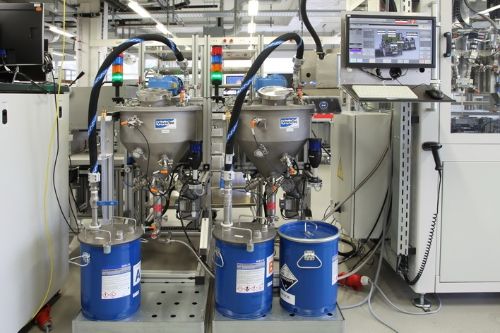ifm ecomatic – Accurately dosed, mixed, fed
Sensors monitor the application of 2-component media.
The heat-conductive paste is exactly dosed and applied to the nearest millimetre onto a PCB. The bonding agent is injected into the housing joint with the same precision, before it is glued while well-dosed pressure is applied. Different sensors ensure continuously high production quality.
A production plant at ifm ecomatic in Kressbronn: This is where the new ecomat controllers of the third generation are produced. These controllers for mobile use have to withstand strong stress under adverse environmental conditions, such as in mobile machines where they are exposed to vibrations and moisture. This means special requirements on the production process.

Application of the 2-component heat-conductive paste onto the PCB.
The station comprises four production processes: During the gluing process, a 2-component glue is injected in the groove along the housing rim and permanently bonds the two housing parts when they are pressed against each other.
This ensures ingress resistance according to the protection rating IP 67. Then follows the joining process, which is carried out automatically to avoid errors caused by manual production. In a third step, the heat-conductive paste is applied onto the PCB. A 2-component heat-conductive paste is precisely applied onto the heat-producing components of the PCB. It bonds with the aluminium die-cast housing which, in turn, dissipates the heat. At the end, the housing is screwed.
Three companies in cooperation
The specially developed system is the result of the cooperation of three companies: The company Fichter Maschinen GmbH from Eichstetten am Kaiserstuhl has built the system. The company Viscotec from Töging am Inn has specialised on the supply of the 2-component media – here the glue and the heat-conductive paste. And ifm is not only the originator and operator of the system but also the manufacturer of the installed sensors.
Martin Baumann from Fichter Maschinen: "Here we have designed a machine for the company ifm which carries out various joining processes and two dosing processes for two 2-component materials. The heat-conductive paste we use here is of very high viscosity and we had to try hard, in cooperation with the company Viscotec, to provide the dosing pumps with enough material."
Rolf Aberle from Viscotec explains the special requirements this project has on his company: "We deal with the removal of the materials from the delivery container, the supply, and, if applicable, the treatment up to the dosing head. There is a container pumping system which fills the material from the container into the supply tank via a vacuum and then supplies the material, under controlled pressure, to the dosing head. During this process, level sensors are used for monitoring tasks. Imagine the 2-component glues as below: The two media are homogeneously mixed in a static mixer. The 2-component heat-conductive paste is supplied to the 2-component mixing head via two separate supply lines. The media are homogeneously mixed by means of a static mixing head and then applied onto the PCB."
Lothar Geschwind from ifm adds: "This procedure had to be developed so that process safety is ensured, because the system automatically joins parts and in the end, we have to avoid that reject parts are produced which would cause unnecessarily high production costs."


Picture 1: Different 2-component media are mixed in the containers. Sensors monitor the level and the temperature. Picture 2: The 2-component media in the mixer are monitored for temperature and level.

In this system, heat-conductive paste and sealing compound are applied and the product passes through the final joining process.
Efficient sensors
To monitor the complex production process, different sensors from ifm are used. Numerous ifm PN-type pressure sensors in various pipes precisely monitor the supply of the 2-component media by means of pressure measurement. This ensures a continuously perfect mixing ratio. The ceramic measuring cell of the sensors is long-term stable and overload protected. This ensures continuous product quality, even when pressure peaks occur.
The PQ-type pressure sensors are integrated in the supply lines of the different pneumatically-controlled arms and grippers. They detect deviations from the intended operating pressure so that the system can be stopped at once. Expensive scrap is avoided. The two-colour LED display does not only clearly indicate the measured value on site, but the colour change (green/red) visualises the operating status.
The end positions of the pneumatic cylinders are precisely detected by means of ifm cylinder sensors and transmitted to the controller via a switching signal.
Two photoelectric fork sensors with fine light beam help reference the fine nozzle applying the glue. The needle of the nozzle is moved until it hits the point of intersection of the two light beams where the X and Y axes meet. Then the starting position is set. The area of application of photoelectric fork and angle sensors is the detection of very small parts. An advantage of photoelectric fork or angle sensors is that transmitting and receiving elements are always perfectly aligned towards each other which is owed to the design. Maladjustment of the fine light beam is almost impossible.


Picture 1: Cylinder sensors precisely monitor the end positions of the piston through the cylinder wall. Picture 2: Two photoelectric fork sensors with fine light beam during the reference movement of the fine nozzle.
LMT-type level sensors are installed on the tank to monitor the contents. They are suited both for liquid and viscous media. The innovation: They reliably suppress deposits or foam. This ensures precise level detection, even with difficult media.
Moreover, numerous inductive and photoelectric sensors are used for position detection of arms, flaps or other moving elements. In short: ifm offers a complete range of high-performance sensors for ideal process monitoring.
Conclusion
The perfect teamwork of the companies Fichter, Viscotec and ifm shows how demanding application requirements are reliably and efficiently implemented on a compact production machine.

Different sensors monitor pressures, temperatures and positions on the system.